

2015 FEB 7
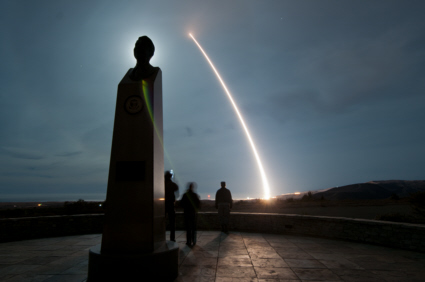
A Minuteman III strategic missile arcs skyward during a test launch from Vandenberg AFB on December 17. In this time exposure, a statue of Ronald Reagan is silhuetted by the full moon as observers in the foreground watch the launch. U.S. Air Force photo by Tech Sergeant Vincent Mouzon
(DEC 17) VANDENBERG AIR FORCE BASE, Calif. - An unarmed Minuteman III intercontinental ballistic missile was launched during an operational test at 4:36 a.m. here Tuesday from Launch Facility-04 on north Vandenberg.
Col. Brent McArthur, 30th Space Wing vice commander, was the launch decision authority.
"This was our twelfth and final launch for 2013," said McArthur. "I am proud of this team of professionals who worked so hard to make this mission a success. Now the team can take some time to enjoy the holidays with family and friends; after the holidays we'll start preparing for a busy 2014 launch schedule."
Vandenberg AFB
(DEC 13) WASHINGTON, D.C. - NASA has selected Space Exploration Technologies Corporation (SpaceX) of Hawthorne, Calif., to begin negotiations on a lease to use and operate historic Launch Complex (LC) 39A at the agency's Kennedy Space Center in Florida.
Permitting use and operation of this valuable national asset by a private-sector, commercial space partner will ensure its continued viability and allow for its continued use in support of U.S. space activities.
NASA will begin working with SpaceX to negotiate the terms of its lease for LC-39A. During those ongoing negotiations, NASA will not be able to discuss details of the pending lease agreement.
Since the late 1960s, Kennedy's launch pads 39 A and B have served as the starting point for America's most significant human spaceflight endeavors -- Apollo, Skylab, Apollo-Soyuz and all 135 space shuttle missions. LC-39A is the pad where Apollo 11 lifted off from on the first manned moon landing in 1969, as well as launching the first space shuttle mission in 1981 and the last in 2011.
NASA

An Atlas V rocket carrying a classified payload and several small satellites heads downrange following liftoff from Vandenberg AFB on December 5. Dimitrii Zagorodnov recorded the launch in this 155-second time exposure from Santa Barbara, Calif. Image Copyright 2013 Dimitrii Zagorodnov. Used with permission.
(DEC 6) VANDENBERG AIR FORCE BASE, Calif. - A United Launch Alliance Atlas V rocket carrying a National Reconnaissance Office payload launched by Team Vandenberg from Space Launch Complex-3 here Thursday at 11:14:30 PST.
Col. Keith Balts, 30th Space Wing commander, was the launch decision authority.
"This was our eleventh launch for 2013 and I couldn't be more proud of this team of professionals," said Balts.
"This new capability represents our commitment to enhanced competitive launch services in support of national defense."
Vandenberg AFB
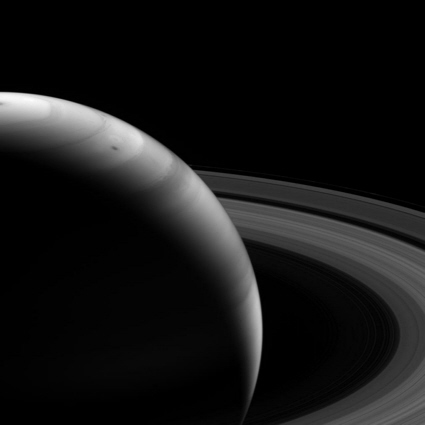
Saturn's clouds take on the appearance of an impressionist's painting in this near infrared Cassini spacecraft image released November 18. The view was acquired at a distance of approximately 994,000 miles (1.6 million kilometers) from Saturn. The Image scale is 57 miles (92 kilometers) per pixel. The Jet Propulsion Laboratory, a division of the California Institute of Technology in Pasadena, manages the mission for NASA's Science Mission Directorate in Washington. Image: NASA/JPL-Caltech/Space Science Institute
(NOV 20) LOS ANGELES AIR FORCE BASE, El Segundo, Calif . - In its 60 year history, the Air Force Space and Missile Systems Center has successfully launched some of the largest and most sophisticated satellites ever created. More
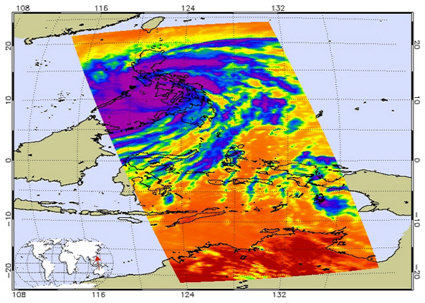
Eleven years after its launch from Vandenberg AFB, NASA's Aqua spacecraft continues to monitor Earth's environment. The Atmospheric Infrared Sounder (AIRS) instrument on the spacecraft captured this infrared image of Super Typhoon Haiyan at 8:59 p.m. PST Nov. 7. The storm's coldest cloud-top temperatures and areas of heaviest rainfall are depicted by the brightest shades of purple. Image courtesy of NASA/JPL-Caltech
(NOV 8) This week, Jupiter-sized sunspot AR1890 unleashed two brief but intense X-class solar flares and numerous M-class solar flares. More eruptions are in the offing as the sunspot turns to directly face Earth over the weekend.
SpaceWeather.com
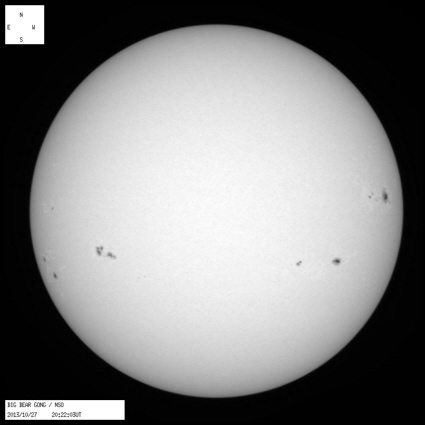
Increased solar activity in late October was accompanied by numerous sun spots as shown in this Big Bear Solar Observatory GONG+ instrument image taken on October 27. The increased solar activity was accompanied by excellent high frequency radio conditions. Image Credit: Big Bear Solar Observatory/New Jersey Institute of Technology
(OCT 22) SCHRIEVER AIR FORCE BASE, Colo. -- The Air Force's latest weather satellite may seem like a silent and static piece of technology as it stands in a California hangar in preparation for a springtime launch. More
(OCT 17) PASADENA, Calif. -- Examination of the Martian atmosphere by NASA's Curiosity Mars rover confirms that some meteorites that have dropped to Earth really are from the Red Planet. More
(OCT 8) TUCSON, Ariz. - A planet 40 light years from our solar system, believed to be the first-ever discovered planet to consist largely of diamond, may in fact be of less exquisite nature, according to new research led by University of Arizona astronomy graduate student Johanna Teske. More
(SEP 30) PASADENA, Calif. - NASA's Cassini spacecraft has detected propylene, a chemical used to make food-storage containers, car bumpers and other consumer products, on Saturn's moon Titan. More
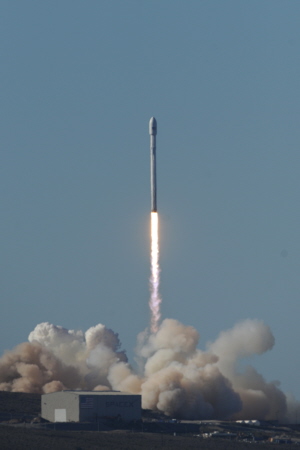
A SpaceX Falcon 9 rocket lifts off from Space Launch Complex 4-East at Vandenberg AFB on September 29. The launch was SpaceX's first-ever from the West Coast. U.S. Air Force Photo/Michael Peterson
(SEP 29) VANDENBERG AIR FORCE BASE, Calif. - Team Vandenberg launched its first-ever SpaceX launch from Space Launch Complex-4 here Sunday at 9 a.m.
Col. Keith Balts, 30th Space Wing commander, is the launch decision authority.
"I am truly honored to work with such an amazing team here at Vandenberg," said Balts. "With safety at the forefront during all launch operations, we highlighted our mission three times in one week, culminating in today's historic launch with SpaceX. What I have seen in the past few months as Wing Commander is a true testament to the professionalism and dedication the men and women of Vandenberg have toward our mission."
30th Space Wing's 1st Air and Space Test Squadron was the lead for all launch site certification activities at Vandenberg for SpaceX as an Evolved Expendable Launch Vehicle New Entrant. Under the authority of the Space and Missile Systems Center, the Squadron evaluated SpaceX's flight and ground systems, processes and procedures for this inaugural space launch campaign for the upgraded Falcon 9 rocket.
Vandenberg AFB
(SEP 26) VANDENBERG AIR FORCE BASE, Calif. - An unarmed Minuteman III intercontinental ballistic missile was launched during an operational test at 3:33 a.m. here Thursday from Launch Facility-9 on north Vandenberg.
Col. Brent McArthur, 30th Space Wing vice commander, was the launch decision authority.
"It is so exciting to see our mission in action," said McArthur. "We have the potential to launch three times this week, and the last time we did that was back in July of 2004. I am proud of this team. Everyone came together despite the challenges thrown our way to support a second safe and successful launch this week, and nine so far for the year."
Vandenberg AFB
(SEP 25) VANDENBERG AIR FORCE BASE, Calif. - Team Vandenberg is scheduled to launch its first-ever SpaceX launch from Space Launch Complex-4 here Sunday with a targeted launch window beginning at 9 a.m. PDT.
Col. Keith Balts, 30th Space Wing commander, is the launch decision authority.
"Our mission is to provide unique capabilities for assured access to and from space for our nation," said Balts. "This is a huge stepping stone for Vandenberg and our SpaceX mission partners and I am impressed with the amount of innovation, dedication and professionalism that was put into making this historic event happen."
30th Space Wing's 1st Air and Space Test Squadron is the lead for all launch site certification activities at Vandenberg for SpaceX as an Evolved Expendable Launch Vehicle New Entrant. Under the authority of the Space and ground systems, processes and procedures for this inaugural space launch campaign for the upgraded Falcon 9 rocket.
"This is historic event for Vandenberg AFB and we are excited to be a part of it," said Lt. Col. Joseph Imwalle, 1ASTS commander. "The Squadron is committed to making the new process of EELV certification successful and to achieving the vision of more affordable operational spacelift capabilities for the Department of Defense without compromising reliability."
Vandenberg AFB
(SEP 24) VANDENBERG AIR FORCE BASE, Calif. - An operational test launch of an unarmed Minuteman III intercontinental ballistic missile is scheduled for Thursday between 3:01 and 9:01 a.m. from Launch Facility-9 here on north Vandenberg.
Col. Brent McArthur, 30th Space Wing vice commander, is the launch decision authority.
"We are excited to support another launch here Thursday," said McArthur. "Although this week may seem challenging with the number of launches, we are eager and ready to continue to support our customers and achieve another safe and successful launch for the Western Range."
Vandenberg AFB
(SEP 22) BARKSDALE AIR FORCE BASE, La. - An unarmed Minuteman III intercontinental ballistic missile was launched during an operational test at 3:01 a.m. (PDT) today from Vandenberg AFB, Calif.
The launch team, under the direction of the 576th Flight Test Squadron, included members from the 91st Missile Wing, Minot AFB, N.D., and 90 Missile Wing, F.E. Warren AFB, Wyo.
"The test launch is the culmination of months of hard work and preparation." said Col. Lance Kawane, 576th Flight Test Squadron commander. "The invaluable data we collect helps us to validate the functionality and performance of system components."
The ICBM test launch program supports U.S. strategic deterrence policy as outlined in the 2010 Department of Defense Nuclear Posture Review, by demonstrating the operational credibility of the Minuteman III.
Agencies across the Department of Defense and the Department of Energy will use the data collected from this mission to ensure a safe, secure and effective nuclear deterrent. The United States' ability to maintain a strong, credible nuclear deterrent is a key element of U.S. national security and the security of U.S. allies and friends.
The next test launch of the Minuteman III from Vandenberg is scheduled for Sept. 26.
U.S. Air Force Global Strike Command
(SEP 18) VANDENBERG AIR FORCE BASE, Calif. - An operational test launch of an unarmed Minuteman III intercontinental ballistic missile is scheduled for Sunday between 3:01 and 9:01 a.m. from Launch Facility-10 here on north Vandenberg.
Col. Keith Balts, 30th Space Wing commander, is the launch decision authority. "2013 has proved to be a busy year for the Western Range," said Balts. "Whether we are supporting a mid-morning launch of a Delta-IV or an early morning Minuteman III launch, public safety is always our number one priority."
Vandenberg AFB
(SEP 17) SANTA BARBARA, Calif. - Westmont's powerful Keck Telescope will aim for a double star and two globular clusters during a free, public viewing Friday, Sept. 20, beginning at about 7:30 p.m. and lasting several hours. The best viewing generally occurs later in the evening. In case of inclement weather, please call the Telescope Viewing Hotline at (805) 5656272 and check the Westmont website to see if the viewing has been canceled.
The observatory opens its doors to the public every third Friday of the month in conjunction with the Santa Barbara Astronomical Unit, whose members bring their own telescopes to Westmont for the public to gaze through. The Keck Telescope is housed in the observatory between Russell Carr Field and the track and field/soccer complex. Free parking is available near the baseball field.
Thomas Whittemore, Westmont physics instructor, says he hopes to turn the 24inch reflector telescope toward the blue-gold double star Albireo, which will be near zenith an hour after sunset. "The two stars circle one another every 100,000 years," he says. "It is interesting to note that the light you see from this binary system is 400 years old. You are looking at light that has traveled since the time of Galileo."
Westmont College

The latest image of sea surface heights in the Pacific Ocean from NASA's Jason-2 satellite shows that the equatorial Pacific Ocean is now in an extended neutral, or "La Nada" state. "La Nadas" make long-range climate forecasting more difficult due to their greater unpredictability. Yellows and reds indicate areas where waters are relatively warmer and have expanded above normal sea level, while blues and purple areas show where waters are relatively colder and sea level is lower than normal. The near-normal conditions are shown as areas shaded in green. Jason-2 was launched from Vandenberg AFB aboard a Delta II rocket in 2008 June. Image Credit: NASA-JPL/Caltech/Ocean Surface Topography Team
(SEP 12) PASADENA, Calif. -- NASA's Voyager 1 spacecraft officially is the first human-made object to venture into interstellar space. More
(SEP 3) LAS CRUCES, NM - A movement to protect lunar artifacts undertaken by a New Mexico State University professor and her students more than a decade ago has sparked the idea in Congress to protect lunar landing sites. More
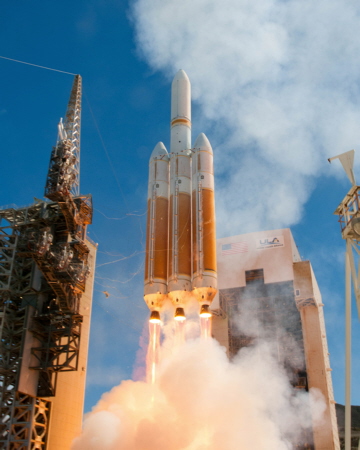
A United Launch Alliance (ULA) Delta IV Heavy rocket carrying a payload for the National Reconnaissance Office (NRO) lifts off from Space Launch Complex-6 at Vandenberg AFB. Designated NROL-65, the mission is in support of national defense. Photo by Pat Corkery, United Launch Alliance
(AUG 28) VANDENBERG AIR FORCE BASE, Calif. -A United Launch Alliance Delta IV-Heavy rocket carrying a National Reconnaissance Office payload launched by team Vandenberg from Space Launch Complex-6 here Wednesday at 11:03 am PST.
Col. Keith Balts, 30th Space Wing commander, was the launch decision authority.
"The teamwork between the 30th Space Wing, the 4th Space Launch Squadron, the National Reconnaissance Office, United Launch Alliance, and numerous other agencies was outstanding," said Balts. "This is Vandenberg's equivalent of an air show or open house and our opportunity to share with the public. We are lucky enough to do this 10-11 times a year."
This was the second Delta IV-Heavy for Vandenberg, with the first launch occurring Jan. 20, 2011 and is the largest rocket ever to launch from the West Coast of the United States.
Vandenberg AFB
(AUG 23) VANDENBERG AIR FORCE BASE, Calif. - A United Launch Alliance Delta IV-Heavy rocket carrying a National Reconnaissance Office payload is scheduled to be launched by team Vandenberg from Space Launch Complex-6 here Wednesday at 10:52 a.m. PST.
Col. Keith Balts, 30th Space Wing commander will be the launch decision authority.
"This will be the second Delta IV-Heavy launched from Vandenberg," said Balts. "We are excited to showcase this national capability for heavy lift on the Western Range in support of the NRO. This is what makes Vandenberg unique because we provide the full spectrum of space lift capabilities from smaller launch vehicles up to and including the Delta IV-Heavy."
The 4th Space Launch Squadron is in charge of mission assurance and safety for this launch operation.
"This is my first launch as the new 4th SLS commander," said Lt. Col. James Bodnar, 4th SLS commander. "We work very closely with the customer throughout the whole process to ensure safety measures and milestones are met at various stages in planning."
This is the second Delta IV-Heavy launched from Vandenberg with the first launch taking off Jan. 20, 2011.
The rocket will carry a national security payload for the NRO.
Vandenberg AFB

A pickup truck pulls Sierra Nevada Corporation's Dream Chaser spacecraft during range and taxi tow testing at NASA's Dryden Flight Research Center, Calif. in early August. The tests were performed to prove the spacecraft's braking and landing systems could handle upcoming captive-carry and approach-landing tests at Dryden. Dream Chaser is a spaceplane being developed to carry people to and from low Earth orbit. Image Credit: NASA/Ken Ulbrich
(AUG 13) SANTA BARBARA, Calif. - Westmont's powerful Keck telescope will feature glimpses of the Moon, Saturn and the Ring Nebula during a free, public viewing Friday, Aug. 16, beginning at about 8 p.m. at the Westmont Observatory. The observatory opens its doors to the public every third Friday of the month in conjunction with the Santa Barbara Astronomical Unit, whose members bring their own telescopes to Westmont for the public to gaze through. The viewing lasts for several hours. In case of inclement weather, please call the Telescope Viewing Hotline at (805) 565-6272 and check the Westmont website to see if the viewing has been canceled.
The Moon, a bit more than 10 days old in its current cycle, will lie fairly low in the sky, skimming across the top of Sagittarius. "The wonderful crater Copernicus will be out of the shadows this evening and, if the seeing is good, the public should be able to see some of the mountainous details in the center of this large crater," says Thomas Whittemore, Westmont physics instructor.
Westmont College
Falcon 9 rockets will deliver three-satellite SARah Constellation that will serve German Ministry of Defense
(AUG 8) Hawthorne, CA - Space Exploration Technologies (SpaceX) will provide the launch services for Germany's second-generation radar reconnaissance satellite system. The satellites, provided by OHB System AG and Astrium GmbH, will replace the current constellation and will be delivered to orbit by two Falcon 9 rockets in 2018 and 2019.
"SpaceX looks forward to working with OHB and Astrium, and we appreciate their confidence in SpaceX to reliably deliver these satellites to orbit," said Gwynne Shotwell, SpaceX President and COO. "These missions are very meaningful for SpaceX as the first contracted for a European government."
OHB will build two passive-antenna synthetic aperture radar (SAR) satellites, and Astrium GmbH will build a larger, phased-array-antenna satellite under contract for OHB. The three-satellite constellation will replace the current OHB-built five-satellite SAR-Lupe constellation.
SpaceX
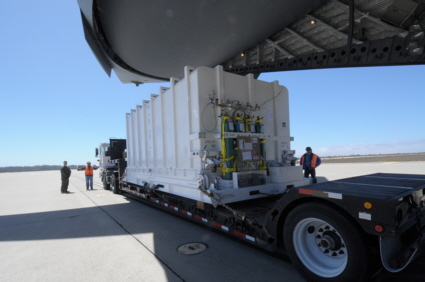
The U.S. Air Force, Lockheed Martin and Northrop Grumman team oversee delivery and preparation of the 19th Defense Meteorological Satellite Program (DMSP) weather satellite to Vandenberg Air Force Base, Calif., on August 1st, 2013, for a 2014 launch. An Air Force C-17 Globemaster III aircraft, operated by the 60th Air Mobility Wing from Travis Air Force Base, Calif., transported DMSP, Flight 19, from Sunnyvale to Vandenberg Air Force Base, Calif. DMSP F19 will undergo final launch preparations, encapsulation and transport to Space Launch Complex 3 East at Vandenberg AFB over the next 250 days and is on track for a scheduled March 2014 launch. U.S. Air Force photo by Sarah Corrice
(AUG 2) LOS ANGELES AIR FORCE BASE, El Segundo, Calif. - The U.S. Air Force, Lockheed Martin and Northrop Grumman team successfully delivered the 19th Defense Meteorological Satellite Program (DMSP), block 5D3, weather satellite to Vandenberg Air Force Base, Calif., where it will be prepared for launch aboard a United Launch Alliance Atlas V launch vehicle. More
(JUL 25) PASADENA, Calf. - The true identity of centaurs, the small celestial bodies orbiting the sun between Jupiter and Neptune, is one of the enduring mysteries of astrophysics. More
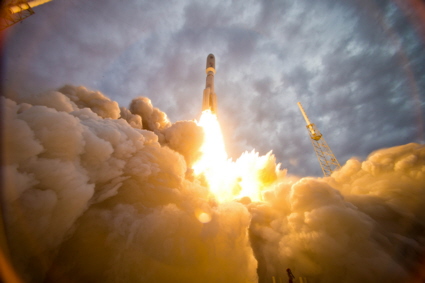
The U.S. Navy's second Mobile User Objective System (MUOS-2) satellite lifts-off from Cape Canaveral Air Force Station, Fla., aboard an Atlas V rocket on July 19. MUOS-2 is part of a next-generation narrowband tactical satellite communications system designed to improve beyond-line-of-sight communications for U.S. forces on the move. MUOS-2 was built at Lockheed-Martin's Sunnyvale, Calif. facility. Photo by Pat Corkery, United Launch Alliance
(JUL 16) SANTA BARBARA, Calif. - Westmont's powerful Keck Telescope will aim for the rings of Saturn and a globular cluster during a free, public viewing Friday, July 19, beginning at about 8 p.m. and lasting several hours. The best viewing generally occurs later in the evening. In case of inclement weather, please call the Telescope Viewing Hotline at (805) 565-6272 and check the Westmont website to see if the viewing has been canceled.
The observatory opens its doors to the public every third Friday of the month in conjunction with the Santa Barbara Astronomical Unit, whose members bring their own telescopes to Westmont for the public to gaze through.
Thomas Whittemore, Westmont physics instructor, says he hopes to turn the 24-inch reflector telescope toward Saturn and its Cassini Division, the gap between the A and B rings. The viewing may also feature the Great Globular Cluster, M13, in Hercules. The cluster, one of the best-known in the northern hemisphere, consists of about 300,000 stars.
Westmont College
(JUL 11) LOS ANGELES AIR FORCE BASE, EL SEGUNDO, Calif. - The Air Force and Lockheed Martin team successfully delivered the third Advanced Extremely High Frequency communication satellite to Cape Canaveral Air Force Station, Fla., where it will be prepared for launch aboard a United Launch Alliance Atlas V launch vehicle.
AEHF-3 completed its California-to-Florida journey July 10 aboard an Air Force C-5 Galaxy aircraft operated by the 60th Air Mobility Wing from Travis Air Force Base, California.
Over the next several months, the satellite will undergo final launch preparations, including encapsulation in the rocket's payload fairing, and transport to Launch Complex 41 at CCAFS for integration with the Atlas V. AEHF-3 is scheduled to launch in fall 2013.
AEHF is a joint service satellite communications system that will provide survivable, global, secure, protected, and jam-resistant communications for high-priority military ground, sea and air assets. The AEHF system is the follow-on to the Milstar system, augmenting, improving and expanding the Department of Defense's Military Satellite Communications architecture.
AEHF-3 was procured from Lockheed Martin Space Systems Company by the MILSATCOM Systems Directorate, part of the Air Force's Space and Missile Systems Center. The MILSATCOM Systems Directorate plans, acquires and sustains space-based global communications in support of the president, secretary of defense and combat forces. The entire MILSATCOM enterprise consists of satellites, terminals and control stations and provides communications for more than 16,000 air, land and sea platforms.
Los Angeles AFB
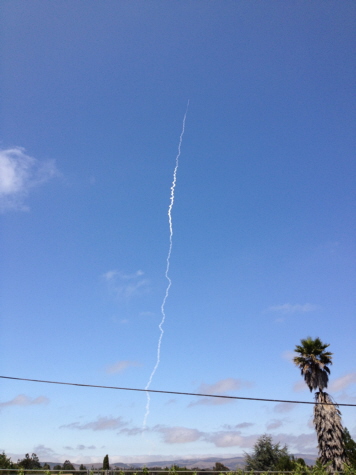
A Ground-based Interceptor climbs into the sky on July 5 as part of a $200 million missile defense test. Greg Peters took this view of the launch from Orcutt, Calif. using his iPhone. Copyright 2013, Greg Peters. Used with permission.
(JUL 5) VANDENBERG AIR FORCE BASE, Calif. - A Ground-based Interceptor, an element of the overall Ground-based Midcourse Defense system, was launched from North Vandenberg Friday at 11:35 a.m. PDT by 30th Space Wing officials, the U.S. Missile Defense Agency, and U.S. Northern Command.
Col. Keith Balts, 30th Space Wing commander, was the launch decision authority.
"Both the 30th Space Wing and the Missile Defense Agency worked hard to get the team ready for today's launch," said Balts. "This was my first MDA launch as the wing commander and I was impressed by the professionalism each member of this team embodied."
The operationally-configured interceptor is designed to intercept and destroy a ballistic missile warhead as part of the Ground-based Midcourse Defense element of the integrated Ballistic Missile Defense System, according to a MDA spokesperson.
Vandenberg AFB
(JUL 2) VANDENBERG AIR FORCE BASE, Calif. - The 30th Space Wing, the U.S. Missile Defense Agency, and U.S. Northern Command are scheduled to conduct a flight test involving the launch of a Ground-Base Interceptor July 5, between the hours of 11:30 a.m. and 3:37 p.m. PDT from North base.
The interceptor will defend against a ballistic missile target launched from the Reagan Test Site on Kwajalein Atoll, Republic of the Marshall Islands. Col. Keith Balts, 30th Space Wing commander, is the Launch Decision Authority.
"The 30th Space Wing has been working closely with our Missile Defense Agency partners here at Vandenberg for months to make this launch a safe and successful one." said Balts. "It's an honor for us to be a part of a test mission so critical to our national security."
The operationally-configured interceptor is designed to intercept and destroy a ballistic missile warhead as part of the Ground-based Midcourse Defense element of the integrated Ballistic Missile Defense System, according to an MDA spokesperson.
Vandenberg AFB
(JUN 27) VANDENBERG AFB, Calif. - The 30th Space Wing provided range support for the launch of an Orbital Sciences Corporation Pegasus XL rocket carrying a NASA payload, which launched at 7:27:52 p.m. PDT, Thursday.
The rocket was launched from an L-1011 aircraft and carried NASA's Interface Region Imaging Spectrograph spacecraft into orbit.
The launch decision authority for this mission was Col. Keith Balts, 30th Space Wing commander.
"Our mission partners and the wing put in a lot of hard work for every launch," said Balts. "It takes a group effort to make each launch mission successful. I want to thank our launch partners and our 30th SW team for working together to provide access to space for this important science-gathering satellite."
The 30th SW provided launch permission, range safety, area clearing and weather support for the launch.
Vandenberg AFB
(JUN 25) Given clear skies and bit of luck, observers over a wide area may be able to see some portion of Thursday's offshore NASA satellite launch. Launch is targeted for 7:27:34 p.m. PDT during a launch window that extends from 7:25:04 to 7:30:04 p.m.
A converted airliner will carry a Pegasus XL rocket containing the IRIS satellite from the Orbital Sciences Corp. facility at Vandenberg Air Force Base to the launch point high above the Pacific about 70 miles southwest of Monterey. When the L-1011 reaches a three-dimensional point in space at 36.000° north, 123.000° west, and 39,000 feet, it will release the rocket. After a five-second fall, the Pegasus first stage will ignite and IRIS will begin a 13-minute climb into orbit.
Observers along the California coast between Vandenberg AFB and Monterey may be able to see the former Air Canada jumbo jet and perhaps one or more chase planes as they fly parallel to the coast on their way to and from the launch point.
For sky watchers in California and neighboring states, the launch takes place before sunset. Under very good conditions, the launch may be visible through binoculars for a distance of up to 150 miles. The best location to view the launch will probably be near Monterey. Coastal low clouds and fog are a problem this time of year, so a viewing site at least 2,000 feet above sea level is preferable.
After sunset, sunlight will illuminate the remnants of the rocket's exhaust at high altitudes. The resulting display could be visible to the naked eye in California, Arizona, and parts of Nevada, Utah, and Mexico.
If you plan to watch the launch from the mountains, remember that mountain roads often have steep drop-offs and no guardrails. Not paying attention to your driving for only a second could kill you. Also, watch out for loose gravel on the road and be very careful when you back up your car.
Brian Webb
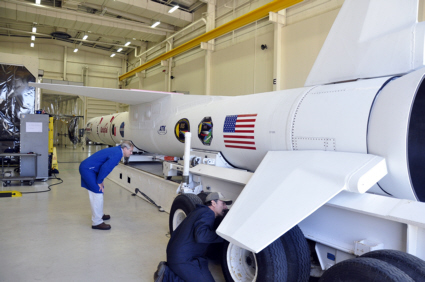
An Orbital Sciences launch team monitors a Pegasus XL rocket as the vehicle and payload are moved from a hangar onto a transporter at Vandenberg AFB. The rocket will be launched June 26 from a jumbo jet flying above the Pacific some 70 miles southwest of Monterey, Calif. and carry NASA's IRIS spacecraft into orbit. Image courtesy NASA
(JUN 11) LOS ANGELES AIR FORCE BASE, El Segundo, Calif. --The Space and Missile Systems Center has signed a Cooperative Research and Development Agreement (CRADA) with Space Exploration Technologies Corp., better known as SpaceX, as part of the company's effort to certify its Falcon 9 v1.1 Launch System for National Security Space (NSS) missions. More
(JUN 7) Last night, Earth passed through a region of south-pointing magnetism in the solar wind. This triggered a G2-class (Kp=6) geomagnetic storm. At its peak, the storm spawned Northern Lights in the USA as far south as Kansas. More auroras are in the offing as a CME is set to deliver a glancing blow to Earth's magnetic field on June 8-9.
SpaceWeather.com
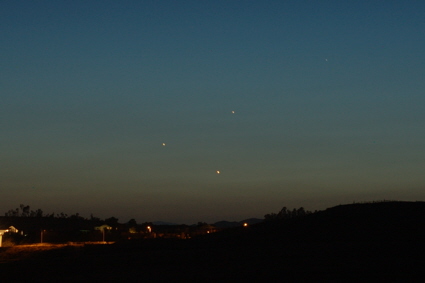
Three planets form a perfect triangle low in the west on the evening of May 26. The Webmaster recorded the event, known as a conjunction, from Ventura County, Calif. using a Nikon D70 digital SLR and 50mm lens. Visible are Venus (bottom), Jupiter (left), and Mercury (upper right). The exposure was 13 seconds at ISO 200 and f/5.6. Copyright 2013, Brian Webb
(JUN 1) Last night, Northern Lights spilled across the Canadian border and descended into the contiguous United States as far south as Colorado and Nebraska. The display was caused by the unexpected arrival of an interplanetary shock wave on May 31st.
SpaceWeather.com
(MAY 22) VANDENBERG AIR FORCE BASE, Calif. - An unarmed Minuteman III intercontinental ballistic missile was launched during an operational test at 6:27 a.m. here Wednesday from Launch Facility-4 on north Vandenberg.
The launch, originally slated for 3:01 to 9:01 a.m. Tuesday, was rescheduled due to a range safety instrumentation issue.
"I am proud of our team," said Col. Brent McArthur, 30th Space Wing vice commander and the launch decision authority. "Because of their professionalism, discipline and intense focus on mission assurance, we saw a safe and successful launch this morning."
Vandenberg AFB
(MAY 10) SANTA BARBARA, Calif. - Westmont's powerful Keck Telescope will zoom in on the craters of the moon, the rings of Saturn and a globular cluster during a free, public viewing Friday, May 17, beginning at about 8 p.m. and lasting several hours. The best viewing generally occurs later in the evening. In case of inclement weather, please call the Telescope Viewing Hotline at (805) 565-6272 and check the Westmont website to see if the viewing has been cancelled.
Thomas Whittemore, Westmont physics instructor, says the moon will be more than seven days into its current cycle. "There will be a number of craters on the terminator, the portion of the moon's surface where the sun is rising," he says. "If the seeing is steady we should get a good glimpse of the jagged edges of these craters as the night advances."
Later in the evening, Whittemore hopes to turn the 24-inch reflector telescope toward Saturn's Cassini Division, the gap between the A and B rings.
Westmont College
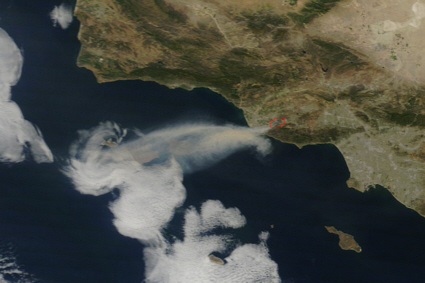
Dry winds fan a wildfire near Camarillo, Calif. and send a thick plume of smoke offshore. The blaze began as a small incident on May 2 just before 07:00 PDT. Within a few hours, the small fire had turned into a major incident. NASA's Terra spacecraft passed over the area later that morning and recorded this view of the fire (red area) and smoke plume. Image courtesy of the MODIS Land Rapid Response Team, NASA GSFC
(MAY 3) Researchers working with high-precision planetary radars, including the Goldstone Solar System Radar of NASA's Jet Propulsion Laboratory, Pasadena, Calif., have discovered strong evidence that the planet Mercury has a molten core. More
(APR 24) MOFFETT FIELD, Calif. - NASA and the Russian Institute of Biomedical Problems, Moscow, are collaborating on a space biology mission aboard an unmanned Russian biosatellite to understand better the mechanisms of how life adapts to microgravity and then readapts to gravity on Earth. More
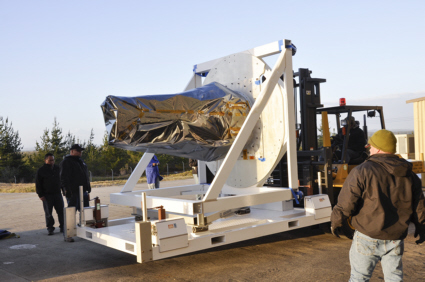
Workers unload NASA's IRIS spacecraft from a truck at the processing facility at Vandenberg where the spacecraft will be readied for launch aboard an Orbital Sciences Pegasus XL rocket. Photo credit: Vandenberg AFB/Randy Beaudoin
(APR 17) GREENBELT, Md. -- NASA's Interface Region Imaging Spectrograph (IRIS) satellite arrived at Vandenberg Air Force Base in California on Tuesday, April 16, to begin its final preparations for launch, currently scheduled no earlier than May 28. More
(APR 11) A strong M6-class solar flare on April 11th has hurled a CME toward Earth. Geomagnetic storms and high-latitude auroras are possible when the fast-moving cloud reaches our planet on April 13th.
SpaceWeather.com
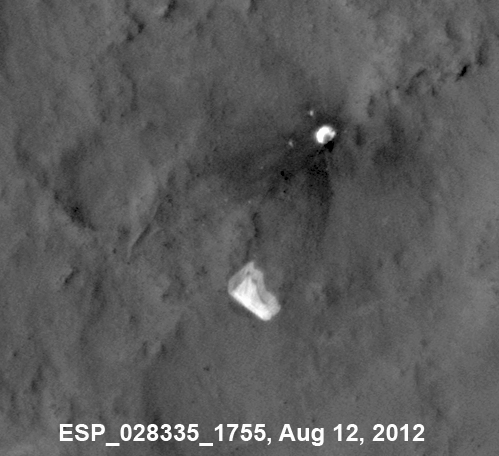
The discarded parachute from NASA's Curiosity Mars rover appears to flap in the martian wind in an animation released this week by the Jet Propulsion Laboratory. The chute lay on the Martian ground during months after its use in safe landing of the Curiosity rover. Seven images from the HiRISE camera on the Mars Reconnaissance Orbiter were combined to create the animation. The University of Arizona, Tucson, operates the orbiter's HiRISE camera, which was built by Ball Aerospace & Technologies Corp., Boulder, Colo. The Jet Propulsion Laboratory in Pasadena, Calif. manages the Mars Reconnaissance Orbiter and Mars Science Laboratory projects for NASA. Image Credit: NASA/JPL-Caltech/Univ. of Arizona
(APR 3) A laboratory experiment at NASA's Jet Propulsion Laboratory, Pasadena, Calif., simulating the atmosphere of Saturn's moon Titan suggests complex organic chemistry that could eventually lead to the building blocks of life extends lower in the atmosphere than previously thought. More
(MAR 25) PASADENA, Calif. - NASA and international researchers have discovered that Earth's moon has more in common than previously thought with large asteroids roaming our solar system. More
Despite optimistic predictions, Comet Pan-STARRS proved to be difficult to see for many northern hemisphere sky watchers. The Webmaster photographed the elusive object (click for full view) low in the west at dusk on March 13 from Ventura County, Calif. The comet had passed near the Sun and entered the evening sky just days earlier. To image the object, the Webmaster used a vintage Nikon D70 digital SLR, 50mm lens, and an exposure of 15 seconds at f/4. Copyright 2013, Brian Webb
(MAR 20) PASADENA, Calif. - "The Voyager team is aware of reports today that NASA's Voyager 1 has left the solar system," said Edward Stone, Voyager project scientist based at the California Institute of Technology, Pasadena, Calif. "It is the consensus of the Voyager science team that Voyager 1 has not yet left the solar system or reached interstellar space. In December 2012, the Voyager science team reported that Voyager 1 is within a new region called 'the magnetic highway' where energetic particles changed dramatically. A change in the direction of the magnetic field is the last critical indicator of reaching interstellar space and that change of direction has not yet been observed."
Jet Propulsion Laboratory
(MAR 15) WASHINGTON - The United States will add more ground-based ballistic missile interceptors to its arsenal to guard against increased threats from North Korea and Iran, Defense Secretary Chuck Hagel announced today. More
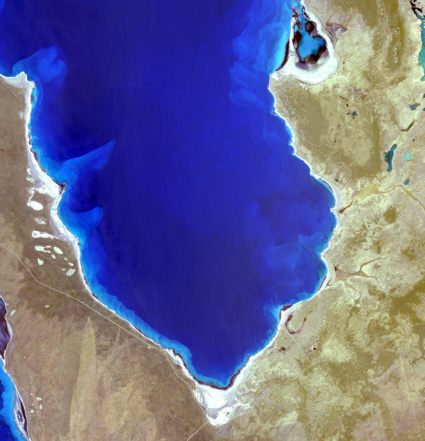
The blue waters of Shark Bay contrast with the surrounding land of Western Australia in this Terra spacecraft image released by the Jet Propulsion Laboratory on March 5. Shark Bay contains the Hamelin Pool Marine Nature Reserve, one of the very few places in the world where living stromatolites are found. The image was recorded using Terra's ASTER instrument. Terra was launched from Vandenberg AFB in 1999 December. Image courtesy NASA/GSFC/METI/Japan Space Systems, and U.S./Japan ASTER Science Team
(MAR 5) SUNNYVALE, Calif. - The U.S. Air Force has awarded Lockheed Martin [NYSE: LMT] a $284.4 million fixed-price contract to procure long lead parts for the fifth and sixth Geosynchronous Earth Orbit (GEO) satellites in the Space Based Infrared System (SBIRS) missile warning constellation.
Featuring a mix of GEO satellites, hosted payloads in highly elliptical earth (HEO) orbit, and associated ground hardware and software, the SBIRS program delivers resilient and improved missile warning capabilities for the nation while simultaneously providing significant contributions to the military's missile defense, technical intelligence and battlespace awareness mission areas.
Lockheed Martin previously received a contract to complete non-recurring engineering activities for GEO-5 and 6 and procure select long lead spacecraft parts enabling supplier production lines to deliver the lowest possible price for each component. This next phase authorizes the purchase of the remaining long lead spacecraft components. A final contract for full production under fixed-price terms will be awarded at a later date.
Lockheed Martin's SBIRS contracts include four HEO payloads, four GEO satellites, and ground assets to receive, process, and disseminate the infrared mission data. Under the new contract, the team will procure long lead parts for the fifth and sixth GEO satellites.
Two HEO payloads and the first geosynchronous (GEO-1) satellite have already been launched. GEO-2 is scheduled for launch in March of 2013.
Lockheed Martin
(MAR 1) Hawthorne, Calif. - Today, Space Exploration Technologies (SpaceX) successfully launched its Falcon 9 rocket and Dragon spacecraft to orbit for SpaceX's second mission under its Commercial Resupply Services (CRS) contract with NASA. Falcon 9 completed its job perfectly, continuing its 100 percent success rate. More

A large meteor streaked over Russia's Chelyabinsk region on the morning of February 15, causing widespread damage and 1,000 injuries. Scientists from Colorado State University analyzed imagery from a U.S. DMSP satellite that passed over the region moments later and found the trail left by the meteor as it entered Earth's atmosphere. Vandenberg AFB, California serves as the launch site for the DMSP military weather satellite program. Image courtesy Colorado State University
(FEB 22) CAPE CANAVERAL, Fla. -- NASA's Launch Services Program at the agency's Kennedy Space Center in Florida has selected United Launch Services, LLC of Englewood, Colo., to provide Delta II launch services for the Ice, Cloud and Land Elevation Satellite (ICESat)-2 mission, currently scheduled for July 2016.
A firm fixed-price launch service task order has been awarded under the indefinite-delivery, indefinite-quantity NASA Launch Services (NLS) II contract. NASA's total cost to launch ICESat-2 is $96.6 million, including payload processing, integrated services, telemetry, reimbursables and other launch support requirements.
The Delta II rocket will place the ICESat-2 spacecraft into a near-circular Earth polar orbit following liftoff from Space Launch Complex-2 at Vandenberg Air Force Base in California. ICESat-2 is a continuation of the global time series of precision ice topography measurements initiated by the first ICESat mission. ICESat-2 will measure changes in the elevation of the polar ice sheets to understand their contribution to current and future sea-level rise. It also will characterize polar-sea ice thicknesses and global vegetation heights to understand their connections to the Earth system.
Subcontractors performing work for United Launch Services include Pratt & Whitney Rocketdyne of Canoga Park, Calif., Alliant Techsystems, Inc of Magna, Utah and Aerojet of Sacramento, Calif. United Launch Services' United Launch Alliance provides the Delta II and launch services.
NASA's Launch Services Program at Kennedy Space Center is responsible for management of the ICESat-2 launch service acquisition and implementation.
NASA
(FEB 11) VANDENBERG AIR FORCE BASE, Calif. - Team Vandenberg launched a United Launch Alliance Atlas V rocket carrying a NASA payload from Space Launch Complex-3 at 10:02 a.m. here Monday.
Col. Nina Armagno, 30th Space Wing commander, was the launch decision authority.
"We completed our mission of supporting a safe and successful launch," said Armagno, "I am so proud of my team on another job well done."
It was the sixth Atlas V launch for Vandenberg.
The 30th Space Wing and NASA hosted a launch viewing party at Providence Landing Park in Lompoc that brought in nearly 1,800 spectators from all over California.
"Our communities have supported our base and our mission for many years," said Larry Hill, 30th Space Wing Public Affairs community relations chief. "It was great to see such an amazing turnout for this launch."
Mobility, the rock band from United States Air Force Band of the Golden West, played for the launch spectators.
Vandenberg AFB
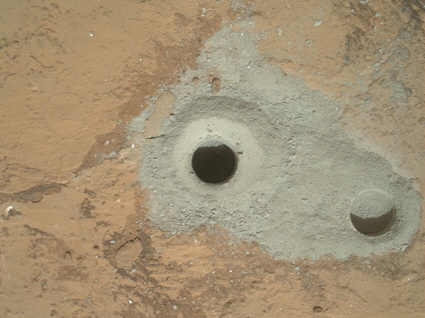
The first-ever holes drilled into a martian rock are visible in this image released on February 9. NASA's Curiosity Mars rover recently made the holes to obtain a sample for analysis from inside of the rock. The Jet Propulsion Laboratory in Pasadena, Calif. manages the Curiosity mission for NASA. Image courtesy NASA/JPL-Caltech/MSSS
(FEB 8) An Atlas V rocket carrying the Landsat Data Continuity Mission (LDCM) spacecraft is scheduled for launch from Vandenberg AFB on February 11. Plans call for the Atlas to lift off from Space Launch Complex 3 (SLC-3) at south Vandenberg at 10:02 PST, the start of a launch window that extends until 10:50 PST. However, issues such as technical problems, bad weather, or ships or aircraft straying into the range can cause the launch to happen at any time during the window or to be rescheduled for another day.
At liftoff, the Atlas will rise vertically from SLC-3 for several seconds before it slowly begins to pitch over and head toward the south. The vehicle will briefly produce a contrail as it passes through a zone that extends roughly from 33,000 to 38,000 feet above sea level.
The Atlas V rocket variant for slated for launch on Monday uses liquid propellant engines and no strap-on solid rocket motors. Unlike solid rocket motors, which produce a brilliant flame, liquid propellant engines produce a much fainter flame. At launch time, the Sun will be well above the horizon, creating a bright sky background. The rocket's use of liquid propellants and the bright sky will greatly diminish the visibility of the launch.
Under the best of circumstances, the Atlas V will probably only be visible for the first few minutes of flight from liftoff to first stage cutoff and stage 1/2 separation.
Under good conditions, observers within seven miles of the launch pad should enjoy a nice display. For observers in outlying areas the display will be very subdued.
Under very good conditions, the first stage flame may be visible to the naked eye as far away as Carpinteria, Pismo Beach, and Taft. The short contrail from the first stage may be visible as far away as Pasadena, King City, and Bakersfield.
Brian Webb
(FEB 1) ARLINGTON, VA - President Obama today awarded 12 eminent researchers the National Medal of Science and 11 extraordinary inventors the National Medal of Technology and Innovation, the highest honors bestowed by the U.S. government upon scientists, engineers and inventors. The recipients received their awards at a White House ceremony. This marks the 50th anniversary of the presentation of the first National Medals of Science in 1963 by President John F. Kennedy.
Those honored include astronomer Sandra Faber of the University of California, Santa Cruz who was recognized for "...leadership in numerous path-breaking studies of extra-galactic astronomy and galaxy formation and for oversight of the construction of important instruments, including the Keck telescopes."
Faber is a professor of astronomy and astrophysics at the University of California Observatories and the Lick Observatory. Her research, which focuses on the formation and evolution of galaxies and the evolution of structures in the universe, has revolutionized the way cosmologists understand and model the universe. She leads a Hubble Space Telescope project designed to give scientists a view of galaxy formation nearly as far back as the Big Bang.
National Science Foundation
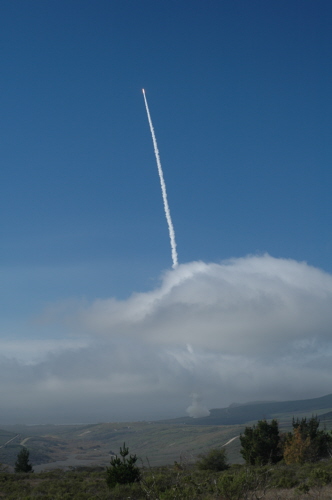
A Ground Based Interceptor (GBI) climbs following a silo launch from Vandenberg AFB on January 26. The launch was performed to test improvements to the anti-missile kill vehicle carried atop the GBI. Photo by Brian Webb
(JAN 26) The Missile Defense Agency (MDA) successfully completed a flight test of a three-stage ground-based interceptor (GBI), launched from Vandenberg Air Force Base, Calif., at 2 p.m. (PST) today.
Data from this flight test will be used to evaluate the Exoatmospheric Kill Vehicle system performance in a flight environment. If a target missile were present, the Exoatmospheric Kill Vehicle would collide directly with the threat warhead to perform a hit-to-kill intercept. Engineering data from this test will be used to improve confidence for future intercept missions.
A target missile launch was not planned for this flight test. After performing fly out maneuvers, the three-stage booster deployed the Exoatmospheric Kill Vehicle to a designated point in space. After separating from the booster, the Exoatmospheric Kill Vehicle executed a variety of pre-planned maneuvers to collect performance data in space.
Initial indications are that all components performed as designed. Program officials will assess and evaluate system performance based upon telemetry and other data obtained during the test.
Today's event, designated Ground-Based Midcourse Defense Control Test Vehicle (GM CTV)-01, is part of an extensive test series initiated after the Flight Test Ground-Based Interceptor (FTG)-06a failure in December 2010. The Exoatmospheric Kill Vehicle flown during GM CTV-01 was modified based on findings from the FTG-06a Failure Review Board. This test is the critical first step in returning GMD to successful intercept testing.
U.S. Department of Defense
(JAN 24) VANDENBERG AIR FORCE BASE, Calif. - The 30th Space Wing and the U.S. Missile Defense Agency are scheduled to conduct a flight test exercising elements of the Ground-Based Midcourse Defense system Jan. 26, between the hours of 2 and 6 p.m on North base.
Col. Nina Armagno, 30th Space Wing commander, is the Launch Decision Authority.
"Vandenberg Hawks are working with MDA to provide safe launch operations for the test," " said Armagno."It's a pleasure to work with our MDA mission partners."
The test will involve the launch of a three-stage Ground-Based Interceptor missile. It does not involve an intercept, and no target missile will be launched. MDA will use the test results to improve and enhance the GMD element of the Ballistic Missile Defense System, designed to defend the Nation, deployed forces, friends and allies from ballistic missile attacks, according to an MDA spokesperson.
Vandenberg AFB
(JAN 14) TOOELE ARMY DEPOT, Utah -- After a year of meticulous planning and preparation, Tooele Army Depot has begun to receive and store first- and second-stage C-4 rocket motors from the Trident I C-4 Fleet Ballistic Missile/Submarine-Launched Ballistic Missile from the Missile Defense Agency. More
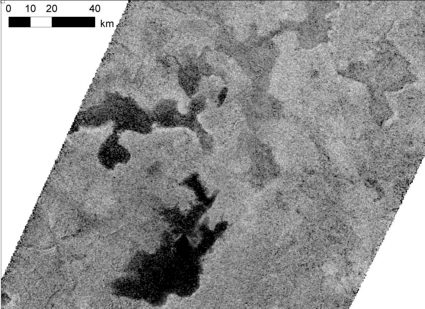
Lakes on Saturn's moon Titan are revealed in a Cassini spacecraft radar image released by the Jet Propulsion Laboratory (JPL) on January 8th. The craft's radar mapper penetrated the thick haze surrounding Titan to show lakes of liquid hydrocarbons (left) and partially filled lakes or saturated ground (top right). JPL, a division of the California Institute of Technology, manages the Cassini mission for NASA's Science Mission Directorate in Washington, DC. Credit: NASA/JPL-Caltech/ASI/Cornell
(JAN 11) One of the biggest sunspots of the current solar cycle is now turning toward Earth. Named AR1654, the active region is crackling with medium-sized (M-class) flares and could be poised to break the recent spell of calm space weather around our planet.
SpaceWeather.com
Copyright © 2013-2015, Brian Webb. All rights reserved.